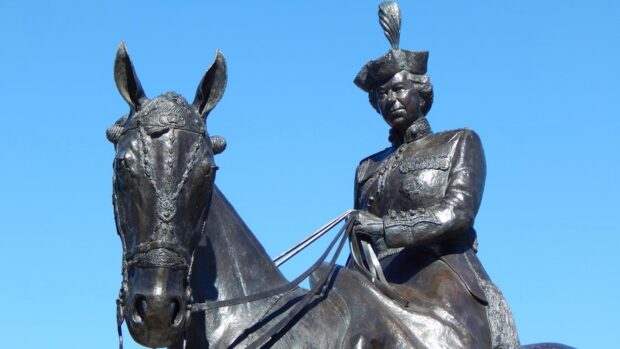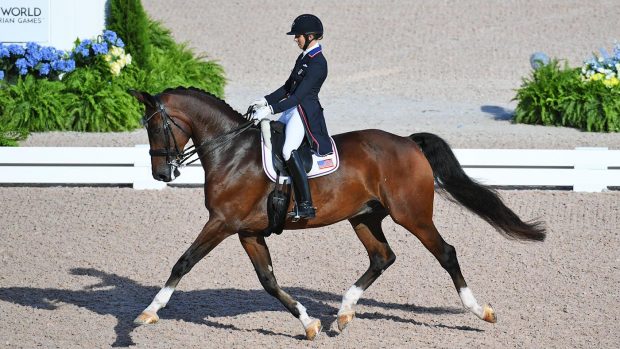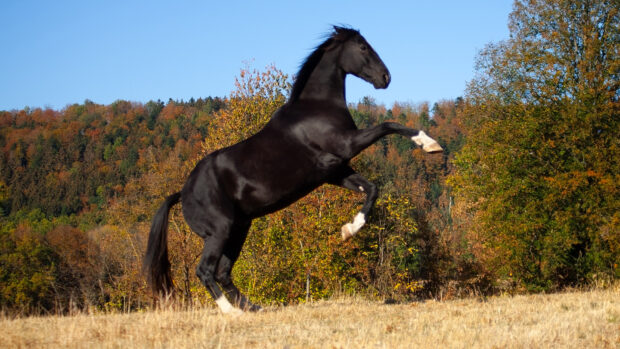There is scarcely a facet of the equestrian world that has not benefited from the patronage – either personal or official – of Her Majesty The Queen. Horse & Hound acknowledges the influence of this great equestrian
THROUGH her happy accident of birth, Queen Elizabeth II had access to horses beyond the dreams of most of her subjects. But she turned it to the equestrian world’s advantage through her genuine love of horses and inestimable knowledge and expertise. Without her involvement and wise counsel, it is arguable that sports such as polo, eventing and driving trials would not have flourished as they did. Throughout her 70-year reign, it was duty first, family second and horses a very close third.
A passion for racing
HOWEVER much The Queen was involved in other aspects of horse sport, racing drove her equestrian interests. Not surprisingly, when British racing introduced the QIPCO Hall of Fame in 2021, she was one of its first inductees.
As a child, The Queen relished visiting Sandringham and Wolferton, the second of the Royal Studs, both in Norfolk, later attending race meetings at the “family” track, Ascot.
Her first big-race adrenaline rush most likely came in 1946, when the King’s Hyperion daughter Hypericum won the 1000 Guineas – after decanting jockey Doug Smith at the start.
The Queen went on to own around 1,600 winners. A fellow equestrian, US President Reagan once gifted a computer which he had programmed to track her racehorses’ activities. He did not know that the royal household already conveyed the outcome of every single run instantly to The Queen, wherever she was in the world.
As a breeder, her encyclopedic knowledge of pedigrees equipped her to maintain the Royal Studs’ role in the evolution of the thoroughbred, and the first decade of her reign was particularly glorious, partly thanks to the great foundation mare Feola. In coronation year, Feola’s grandson Aureole was Derby runner-up. In 1954, he won the Coronation Cup, Hardwicke Stakes and the King George, making the young monarch leading owner of the year – a feat she repeated in 1957.

17 July 1954: Queen Elizabeth II patting her horse, Aureole after he came in first at Royal Ascot.
Almeria was the best-staying filly in 1957, and Pall Mall won the 2000 Guineas in 1958. Other high-class winners were High Veldt, Above Suspicion and Doutelle, while other descendants of Feola – notably world-record money-winner Round Table – impressed elsewhere.
In the 1960s, the royal studs went through a weak patch following the retirement of The Queen’s adviser Captain Charles Moore. Sir Michael Oswald was recruited to run the studs (succeeded by Joe Grimwade), and later looking after her jumping interests until his death in 2021.
The post of racing manager was created for The Queen’s childhood friend Henry, the 7th Earl of Carnarvon. Faster blood was imported and links forged with Kentucky. Another golden era followed in the ’70s, with Highclere winning the 1000 Guineas and Prix de Diane. That great battler Dunfermline took the Oaks under Willie Carson in 1977, The Queen’s silver jubilee year. She also stood the top-class sire Bustino, plus Shirley Heights, first of only two winners in the entire history of the Derby also to be a son and sire of Derby winners (Mill Reef and Slip Anchor).
In the past 40 years, uber-wealthy Arab and Irish owners have dominated the sport. Like other pillars of British racing, The Queen struggled to retain key pedigrees; despite her personal wealth, she insisted that her equine interests ran on a strictly commercial basis.
In 1982, she arguably changed the course of British breeding by selling the filly Height Of Fashion – by Bustino out of Highclere – to Sheikh Hamdan Al Maktoum. The rumoured price of £1m was earmarked to secure the West Ilsley stables for their tenant Major Dick Hern, The Queen’s principal trainer since 1966. One can only guess her private thoughts when Height Of Fashion went on to produce seven big winners including the legendary Nashwan, the only horse ever to win the 2000 Guineas, Derby, Eclipse and King George in the same season. Nashwan was syndicated to stud for £18m (about £70m in today’s money).

The Queen congratulates her horse Estimate, after taking the Ascot Gold Cup on Ladies Day.
In 2008, The Queen enjoyed her first Royal Ascot winner since 1999, Free Agent in the Chesham Stakes and in 2013 became the first reigning monarch to win the Ascot Gold Cup, with the Sir Michael Stoute-trained Estimate. The following year’s Gold Cup provided The Queen with a less appealing and very expensive experience – Estimate tested positive to morphine after finishing second. Hers and other horses’ samples were attributed to feed contamination – but it still meant disqualification from the race.
Lord Carnavon’s son-in-law John Warren became The Queen’s next racing adviser and, despite the difficult market, restored missing links in her breeding programme.
Her great-grandfather King Edward VII won the Derby three times, but this one Classic eluded her. Darley-bred Carlton House provided another chance in 2011. The favourite survived an injury scare earlier in Epsom week, but found French contender Pour Moi too good, finishing third.
Platinum Jubilee year 2022 was expected to provide another shot. Trained by John and Thady Gosden, The Queen’s Reach For The Moon was among the ante-post favourites for the 2022 Derby over the winter, but had a setback which meant he was not fit in time. This son of Sea The Stars won the 2021 Group Three Solario Stakes at Sandown and capped The Queen’s best Flat season since 1988 – 33 winners in all.
Tactical was another Group winner in recent years, though world events prevented The Queen from enjoying all his successes in person. Tactical landed the Windsor Castle Stakes at Royal Ascot 2020, but The Queen stayed away for the first time in 73 years because of the Covid pandemic. Home-bred Tactical also won at the 2021 April meeting in Newmarket – a few days after her husband, the Duke of Edinburgh, died.
A purely practical decision was made to hand King George VI’s Flat-racing interests to the new Queen and his jumpers to The Queen Mother after his death, fostering a widespread assumption that The Queen was disinterested in National Hunt. This was far from the truth; the first horse to run in her colours was in fact a jumper, Monaveen, in 1949. She was present in 1956 when The Queen Mother’s Devon Loch infamously capsized yards from the Grand National winning post when in the lead.
Barbers Shop won or was placed 15 times and finished seventh in The Queen’s first attempt at the Cheltenham Gold Cup in 2009, having the misfortune to run in the same era as Denman and Kauto Star. But she had to wait until a few days short of her 93rd birthday to enjoy a first-ever win at Cheltenham – Sunshade in a (non-Festival meeting) Listed hurdle.
Not just a museum
THE Royal Mews – home of all the non-military ceremonial horses – was founded at Buckingham Palace in 1762. It houses priceless state coaches, but through her enlightened appointment of Lieutenant-Colonel Sir John Miller, MC, as Crown Equerry in 1961, The Queen ensured it would never be “just a museum”.
For 26 years until his retirement, Sir John – an Olympic-shortlisted event rider – balanced tradition and pageantry with modern horse management techniques. He opened the Mews to London-based user groups such as the Civil Service Riding Club and Riding for the Disabled.
He also navigated members of the royal family through their personal interests – notably Prince Philip in carriage driving and the Prince of Wales in hunting and race- riding.
“If someone invents something new with a horse, you name it, The Queen will try it,” Sir John once said. Having witnessed the high jinks of racehorse Hypericum, The Queen called in neurologist Dr Charles Brook when sibling Aureole showed the same waywardness. He spent long and productive periods running his hands over the back and withers.

Camilla, Duchess of Cornwall and The Queen at a demonstration by American trainer Monty Roberts. The Queen thought his methods were “marvellous”.
Thereafter, The Queen had a lifelong interest in “alternative” practices. In the 1980s, she invited Monty Roberts to demonstrate “join-up” to Royal Mews’ staff and encouraged Sir John to coordinate Monty’s first UK tour in conjunction with Horse&Hound. Monty was made an honorary member of the Royal Victorian Order (RVO) in the birthday honours of 2011.
The Queen also took advantage of official gifts from other heads of state – such as Caspian and Haflinger ponies; one of her favourite hacks was Zaman, a small Russian stallion presented to Prince Charles by Mr Kruschev, the future Soviet premier, in 1956.
But she also loved to bag a bargain. Sir John once found a brilliant polo pony for £250, bought from a butcher and stabled in a rail coach.
Ahead of her time, The Queen recognised the significance of organised sport horse breeding in continental Europe. She dispatched Sir John to source Oldenburgers in Germany for the “Windsor grey” carriage teams in the early 1970s.
However, the “core” carriage horse was the Cleveland Bay. The Queen saved the breed’s most influential sire Mulgrave Supreme for the nation, buying him in 1962 to prevent an export sale. Cleveland Bay-crosses were used by Prince Philip for the “new” sport of horse-driving trials, for which he won a world team gold medal in 1980.
The Queen particularly appreciated numerous equine gifts from the Royal Canadian Mounted Police, notably Centenial and Burmese, whom she rode side-saddle at her annual birthday parade, Trooping the Colour, for 18 years.
In 1981, an anti-royalist in the crowd fired six blanks, and the world had a rare glimpse of The Queen’s equestrian prowess as she steadied Burmese in the ensuing panic. Burmese was honoured in a statue in Saskatchewan, Canada, and retired in 1986. Thereafter The Queen rode in a carriage at public parades. She continued to hack out daily, albeit on the safer conveyance of a Fell pony in her advancing years.
The sport of princes
IF racing is the sport of kings, polo is the sport of princes – The Queen’s husband, elder son and grandsons all immersed themselves as players, while The Queen promoted the sport through patronage of Guards Polo Club at Smith’s Lawn, Windsor. She also replenished the post-war drought of high-goal polo ponies through sourcing breeding stock from the Argentine.
As an officer’s wife in Malta from 1949–51, The Queen watched Prince Philip play polo with his uncle Earl Mounbatten, who became mentor to Prince Charles until murdered by the IRA in 1979.
Major Ronald Ferguson later became Prince Charles’s polo manager. In that era, Guards was both the epitome of sporting prowess and a magnet for paparazzi.

The Queen was frequently seen at ringside during Royal Windsor Horse Show.
Elsewhere on the estate, the annual Royal Windsor Horse Show has no more enthusiastic spectator than The Queen, who attended it daily throughout her life. The show was founded in 1943 by her father, King George VI, as a wartime benefit event.
The Princesses Elizabeth and Margaret Rose – taught to ride and drive by Horace Smith and his daughter Sybil – first won Windsor’s private turnout in 1944 with their pony Hans. Subsequent generations all competed at Windsor. The show’s earliest schedules reflected the royal family’s interests, notably with the introduction of the international carriage-driving grand prix. Windsor went on to host the annual National Driving Championships and the 1984 Worlds, in which Prince Philip won a team bronze medal for Britain.
The passion for driving passed to Prince Edward’s family. Prince Philip taught Edward’s wife, Countess of Wessex, to drive and later their daughter Lady Louise Windsor; in 2017, aged 13, she made her Royal Windsor debut, with the French pony chase driven by The Queen at Windsor in 1943.
Natives get royal seal of approval
THE QUEEN was a notable breeder and exhibitor of native ponies. Fells were bred at Balmoral initially for deer-stalking, though later were driven competitively by Prince Philip. Highland ponies were a family tradition. Although official engagements invariably prevented The Queen from attending the Royal Highland Show, her stock was usually in the ribbons. In 2007, The Queen expanded her Highland interests, moving eight mares from Hampton Court to Balmoral. By 2010, that herd numbered 35, with the yearling Balmoral Mandarin reserve champion at the Royal Highland Show.

The Queen with her home-bred Highland mare Balmoral Melody at Royal Windsor Horse Show 2011.
In 2017, The Queen lost five of the Balmoral Highlands to grass sickness, but has turned sadness into a positive by promoting research into this illness ever since.
In 2004, recognising that Royal Windsor had to move with the more professional demands of sport horse producers, show director Simon Brooks-Ward obtained The Queen’s permission to relocate it to her private Frogmore gardens in 2004, building all-weather arenas. The new facility hosted the dual showjumping and dressage European Championships in 2009, finally joining five-star showjumping ranks in 2017, with increased involvement of Rolex, and attracting the world’s very best after an absence of several decades.
The new-look Royal Windsor also included an evening tattoo, born out of the 2002 Golden Jubilee pageant, All The Queen’s Horses.
Another such pageant marked The Queen’s 90th birthday. Only at Royal Windsor could superstars Kylie Minogue, Shirley Bassey and Helen Mirren all appear on the bill – and all be upstaged by a horse.
The Queen never missed a beat of that performance. Noticing the riding of Kinvara Garner, who portrayed the young Elizabeth, she approached her about riding her part-bred Arabian Whalton Highwayman (Fred). Five successful seasons followed, culminating with Fred’s retirement after landing the Royal Windsor championship in 2021.
Gold medals – so near and yet so far
IT was fortuitous that the Master of the Horse (a senior role in the Royal Household) was the 10th Duke of Beaufort, who founded Badminton Horse Trials in 1949. The Queen annually attended up to the mid 1980s, Princess Anne’s success enhancing her interest. The Queen also hosted the second-ever European Eventing Championships at Windsor Great Park in 1955.
As an owner, The Queen came close to Olympic glory in 1956 at Stockholm, with Bertie Hill’s ride, Countryman III. Hill was in contention after the dressage, but the bank around a trakehner was weakened by an overnight deluge and Countryman became straddled when it collapsed under him. Hill dismounted to help, accruing 80 penalties, while The Queen waited anxiously for news in the “D box”. Once freed, the pair galloped home inside the time!
Princess Anne’s first serious eventer, Purple Star, was bred by Sir John Miller out of his Badminton-ride Stella, but it was The Queen’s polo-bred Doublet who took her to European gold. Princess Anne and her daughter Zara Tindall completed a unique family double, both winning European individual gold. Princess Anne won a further European individual silver with The Queen’s Goodwill in 1975, boosting eventing’s media profile even further.
The Queen experienced every mother’s nightmare when Goodwill and Princess Anne survived crashing falls at the 1973 Europeans in Kiev – at the notorious second fence which claimed 35 victims – and the Montreal Olympics in 1976.
The Queen had a second gold medal near miss with Columbus. The grey known as “The Monster” was too strong for Princess Anne so she offered him to Mark Phillips, on the cusp of their romance in 1972. By 1974, Mark was The Queen’s son-in-law; when she presented him with Badminton’s Whitbread Trophy he promptly handed it back to her, as the winning owner. Sadly, that Badminton victory was Columbus’s swansong at top level; that autumn, he slipped a tendon when leading the World Championship cross-country.
Elite event horse breeding had become a more specialised undertaking by the time The Queen’s granddaughter was competing seriously. None of Zara’s greatest achievements came with horses provided by her grandmother, though Zara did compete with Tiger Lily, the result of experiments in breeding coloureds out of The Queen’s Tinkerbell. Tinkerbell’s little family appeared in official pictures to mark the Golden Jubilee in 2002 and The Queen’s 78th birthday in 2004.
Tiger Lily’s son Sunbeam is one of many show horses produced for The Queen by Katie-Jerram Hunnable, though none perhaps as well recognised as Barbers Shop. In the second decade of the millennium, he dominated the fast growing raft of showing classes for retrained racehorses. His many championships included the RoR Tattersalls series final at Hickstead, and three Royal Windsors.
Naturally, The Queen was present for Barbers Shop’s farewell at Windsor, where the world’s press recorded her clear delight at winning a Tesco voucher.
The Queen was the most famous, admired and garlanded person on the planet, but nothing brought out her widest smile than the simple pleasure of owning a horse.




